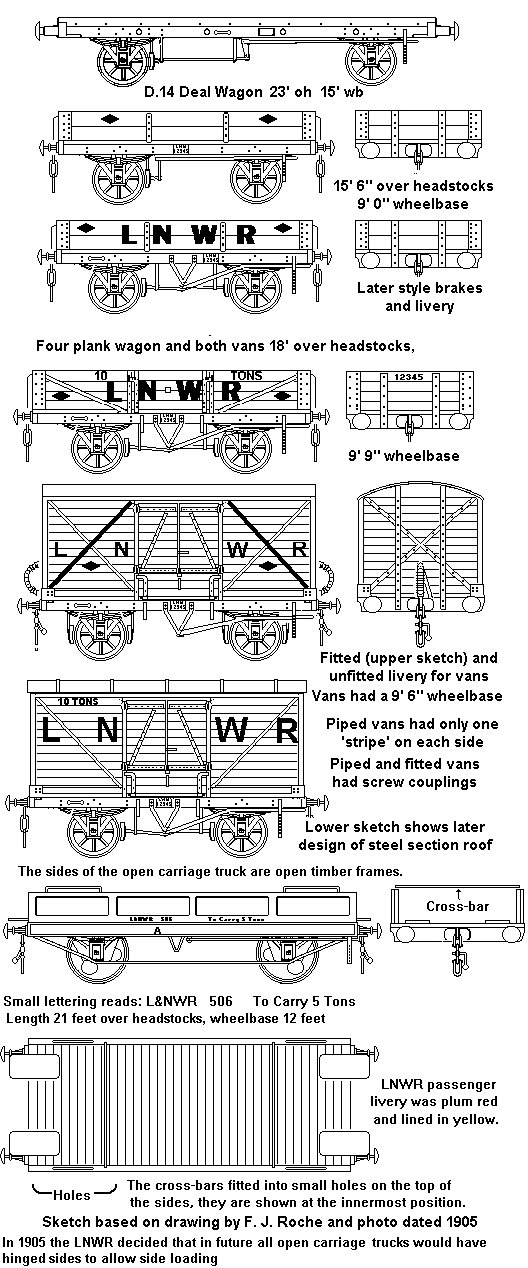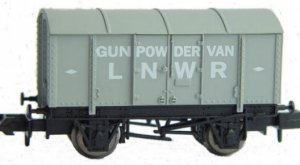
(Note: Numbers in brackets refer to specific references)
The LNWR was born with the amalgamation in 1846 of several companies, the largest being the Liverpool & Manchester, the Grand Junction Railway and the London & Birmingham railway. Within twenty years the LNWR network was virtually completed, including what became the West Coast Main Line from Euston to Carlisle. By the time of the First World War most of this line was quadruple track.. The administrative centre was at Euston in London but the hub of the network was Crewe from where five lines radiated; one west via Chester to Hollyhead and the ferry to Ireland, another north to the Scottish border at Carlisle with a branch to Liverpool. At Carlisle the LNW entered into a close liaison with the Caledonian Railway and thus gained access to Glasgow, Edinburgh and Aberdeen. To the north east a line ran via Manchester to Leeds, to the south east the main line to London ran via Rugby with a branch to Birmingham. The fifth line ran down to the south west to Swansea with a branch to Hereford where a connection with the GWR ran down to Bristol. Other towns served included Huddersfield, Warrington, Preston, Oxford,, Peterborough, Leeds, Shrewsbury, Swansea Carmarthen Abergavenny, Ebbw Vale, and Merthyr, Rugby, Stafford, Warrington, Winwick, Golborne and Runcorn. Running powers on other lines gave access to Hull, Croydon, Doncaster, Peterborough, Cambridge, Newport and Cardiff.. The LNWR had numerous joint working arrangements, enjoying friendly relations with both the Caledonian Railway and the Lancashire & Yorkshire Railway, and later with the Midland Railway.
By the time of the grouping in 1923 the LNWR was one of the three largest railway companies in the country and the route mileage had passed the 2000 mile mark. There were three principal works on the line, coaching stock was built at Wolverton (the original works for the company), goods stock was built at Earlestown, near Warrington and from the 1860's the locomotives were built at Crewe. Around the turn of the century the company worked hard to become as self sufficient as possible. At Crewe the company built its own steel works, one of the first in Britain to produce Bessimer steel. The works built a mill to roll rails sixty feet long, longer than those on any other company for many years. These required fewer joints, offering greater passenger comfort and reduced maintenance costs. Crewe also hosted the company brick works, the signal and telegraph department workshops, a large printing works and even a soap factory. The company pioneered the use of compound engines with high and low pressure cylinders to extract as much power as possible from the steam.
The LNWR carried a great deal of freight, mainly coal from the North West, west Yorkshire and South Wales coal fields, but also textiles, metals and engineering products from the many industrial towns it served. The gravity operated marshalling yard built at Edge Hill, to serve the goods services in Liverpool, was the largest of its kind in the country. Garston Dock near Liverpool was purchased in the 1860's and later enlarged, mainly being used for exports of coal to Ireland. Joint ownership of the North Union and Preston & Wyre Railways with the L&Y provided access to both Preston and Fleetwood docks and (after 1925) traffic from the chemical works near Fleetwood based on the nearby salt mines. The LNW was heavily involved with the traffic to and from Ireland, operating a shipping service from Liverpool on its own account and jointly from Fleetwood (with the L&Y) and from Stranraer (with the MR, Caledonian and Glasgow & South Western). These shipping services featured considerable traffic in cattle from Ireland, the return cargo being coal and general merchandise. The LNW also carried the Irish Mail between London and Hollyhead where it invested in improving the port facilities.
The Lancashire glass making area around St Helens was also served by this company, involving shipments of coal from the Lancashire and west Yorkshire coal fields and the movement of finished glass on specially built vehicles.
Goods stock used a dark grey for the body and chassis with black running gear. The company relied on the registration plate, mounted centrally on the chassis, to carry the vehicle number until the later 1880's when they added the number to the top plank at the end. Early open wagons had only small diamond shapes painted toward either end of the body. The diamonds were inherited from the Grand Junction Railway and were not, I am informed, an illiterate mark. In 1896 they began painting the capacity on the top plank of the wagon side as shown on the sketch on the four plank wagon. Some vans had the capacity shown in the upper left of the body as shown on the sketch of the unfitted van. In 1908 they added the letters LNWR about twelve inches high and in 1911 they stopped adding the diamonds. Very few examples of the diamond symbol were seen by the grouping of 1923.
Vacuum fitted vans had diagonal white stripes on the sides, extending from the lower corners of the body to the tops of the doors. These stripes were certainly used prior to 1904 but I cannot confirm whether they were retained after the 'diamonds' were abandoned. Vans fitted with only a through pipe had only a single diagonal stripe.
Passenger stock had dark maroon (usually called 'plum') lined in yellow and coaches had white upper panels. Non passenger coaching stock had black underframes, the body was painted a dark brown (described as 'plain chocolate' (3)) and grey roofs. Lettering was in plain yellow, the company initials were L&NWR on non passenger coaching stock (3).
Fig ___ LNWR

The LNWR favoured the use of 'flitch plates' on their wagons, so Peco chassis filled with Milliput can be used to good effect as described in article xx (xx xx RM) and already seen on the long wheelbase 'deal wagon' described in article xx (xx xx RM).
Prior to the early twentieth century the most common type of goods wagon was a one plank or two plank type fifteen feet six inches or (after 1898) sixteen feet over headstocks. The one plank wagons were built in large numbers up to 1904 and had eleven inch high sides with an internal depth of nine inches. Sketch XX shows the method used to build my model. This wagon, fitted with foot-boards and hand rails formed the basis of the standard LNW shunters truck and, fitted with metal rails, they were used to carry crates of plate glass.
Two plank drop sided wagons were built specifically for slate traffic, my model uses a frame cut from a Peco 'ventilated van' kit mounted on a cut down Peco ten foot wheelbase chassis. Note the headstocks are not cut away as they serve as door springs.
In 1904 the company introduced a new chassis, eighteen feet long over headstocks with a wheelbase of nine feet nine inches, incorporating the characteristic cut-away at the ends of the headstock. The four plank is easily reproduced using the Peco five plank wagon kit as described in article xx (xx xx RM).
The van is a design dating from the early twentieth century, eighteen feet long on a nine foot nine inch wheelbase chassis. My model is based on the Peco 'ventilated van' kit with new sides and the side channel of the chassis filled to represent the flitch plate. There was no overhang as such to the roof so this has to be sanded down flush with the sides. The resulting model is 1mm too short, and the wheelbase is 0.5mm too long, but it is recognisable as a Dia 88 van, a common type. The unfitted and 'piped' types are much easier to model as the fitted version had clasp brakes however if you have an old Hornby Minitrix chassis in your bits box you can use the modified Peco van body fitted with brake pipes of coiled guitar wire.
Dapol have released a model of an LNWR gunpowder van, they release their models in short runs to allow the production of a range of liveries, so you may need to wait a while for this livery to re-appear.

References:
I was fortunate enough to be given a sneak preview by the LNWR Society of a forthcoming book on LNWR wagons which will be essential reading for any LNWR modeller.
(1) LNWR Portrayed by XXXXXX published by Peco - An excellent guide to modelling this line.
(2) LNWR Liveries by G. Dow, P. Davis, P. Millard & E. Talbot.- HMRS - 1985. Standard reference work on all aspects of design, decor and liveries of the LNWR.
(3) Historic Carriage Drawings Vol. 3 Non Passenger Coaching Stock compiling editor Peter Tatlow - Pendragon Partnership - 2000 A really useful book containing scale drawings and photographs with potted histories and details of livery for a wide range of rolling stock, mostly pre-grouping designs. Highly recommended.
Clubs & Societies:
Membership Secretary
London & North Western Railway Society
Available Models (N/2mm Scale)
Graham Hughes Kits 20, MacKelvie Road, Lamlash, Isle of Arran Strathclyde KA27 8NP
Mr.Hughes offers a kit of a pair of LNWR timber bolster wagons in cast white metal The models require wheels and couplings to complete.
Acknowledgements
I am indebted to Mike Williams of the LNWR Society for his patience and assistance in the preparation of this article. Mike, the editor of the Societies Journal, is currently working on a very detailed book on the goods rolling stock of the LNWR.